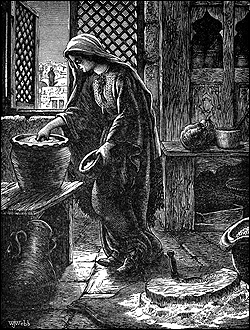
Home > Jesus > Parables of Jesus > Parable of the Leaven
 Parable of the Leaven
Parable of the Leaven
And again he said, "Whereunto shall I liken the kingdom of God? 21 It is like leaven, which a woman took and hid in three measures of meal, till the whole was leavened." — Luke 13:20-21, KJV
This brief parable also appears at Matthew 13:33 and is similar in meaning to the parable of the mustard seed with which it is paired. It is another of our Lord’s illustrations of the power and progression of the eternal kingdom; in this case how the gospel transforms people who receive Jesus Christ, and how the church, despite its meager start, will expand dramatically in power and scope.
Depending on scriptural context, bread is often symbolic of man’s physical or spiritual sustenance. Leaven used to make bread in the ancient Middle East would not have been the yeast we use today but a small piece of leftover dough that had begun to ferment. When added to new dough, it would cause a chemical reaction, permeating throughout until the whole was leavened. In the same way, God's grace enables true faith to spread throughout a believer’s heart, transforming its nature to reflect that of our Father in heaven and redeeming the believer in Christ.
The parable analogizes important truths. First, the leaven represents the call of the gospel, the catalyst of faith. The woman symbolizes the providential agent through which God’s word is delivered, and the meal or flour is the unredeemed human heart in need of transformation. By extension, it also illustrates the growth of the church, with the leaven representing the fledgling early church and the flour the world. Inaugurated with the first advent of Christ, the kingdom of God on earth is progressing toward its culmination at his second coming.
The parable has at times been interpreted in error because of Paul’s assignment of negative connotations regarding leaven to signify corrupting influences within the church. Read in context with the adjacent mustard seed parable and noting Jesus's direct association of the leaven with God’s kingdom helps us to see that this is not the meaning being conveyed here.
The amount of flour mentioned is notable. Commentators have pointed out that “measure” here relates to the ancient Jewish se’ah which is equivalent to about two gallons dry measure, so about six gallons of flour in all. This would generate enough bread to feed over 100 people, emphasizing the power of the leaven to affect a proportionately much larger mass. Such is the power of the gospel message.
In the same way the leaven impacts a lump of dough, the arrival of God's kingdom through the modest earthly circumstances of the incarnation marked the beginning of a process that will culminate in a glorious and complete realization of the eternal reconciliation, reign and blessing promised to believers. Reflecting that process is the evolution of the church, which has grown from a small band of outcast Galileans to a worldwide brotherhood of faith that has blessed many millions. Likewise on an individual level, a Christian’s faith starts small and grows stronger in his walk with the Lord as he moves toward sanctification. From humble beginnings come great results, and what greater result can there be than the inheritance of heaven?
Image:
Webbe, William J. (1830-1904)
Scripture Alone • Faith Alone • Grace Alone • Christ Alone • To the Glory of God Alone
Most scripture quotations taken from the New American Standard Bible® (NASB)